 |
||
|
||
| ||
Part 1. Budget AVC, New Thermaltake, Titan and Zalman Solutions
Well, the year 2004 came quite a long time ago but we haven't ranged the Socket A coolers yet. First of all let's cover the coolers we haven't touched yet and then make up a summary table. AVC 112C80, 112C86L & Z6M330 (Frost)First come three coolers marked AVC (Asia Vital Components, one of the giants of the cooler market) - 112C80, 112C86L and Z6M330. 112C80 is a typical budget-level solution and looks simple: the cooler is based on a weak aluminum heatsink, 78x60x45 mm, with outdated fin parameters (the fin is 1mm thick mm, 2mm step), and equipped with a fan, 60x60x15 mm, rotating at the speed of 4500 rpm, and has a simple two-point mount. 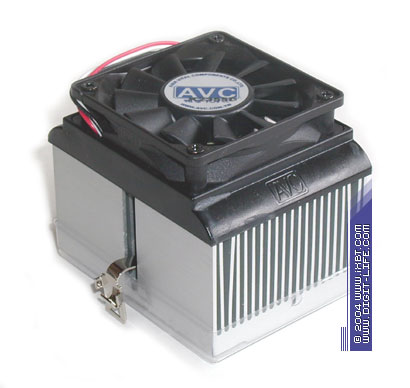 Its modest parameters do not let it look outstanding: 112C80 loses to many budget solutions and demonstrates quite a high noise level. It doesn't make it that attractive, and 112C80 goes down to the bottom of our summary table. Another budget-level model - 112C86L - reminds 112C80 but has its basic features updated: the cooler has a heatsink with a copper disc 33 mm in diameter, a low-level fan, 60x60x15 mm, that rotates at 3000 rpm, and a normal 6-point mount. 
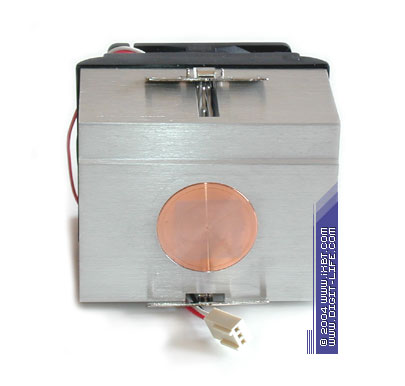 One more budget solution - AVC Z6M330 - looks much more attractive. It features a combined copper and aluminum heatsink, 73x60x33 mm, based on the Crimp Fin technology (the fins are formed by aluminum plates 0.3 mm thick pressed into a copper base). The cooler also has a fan 60x60x15 mm, 4000 rpm, and a normal 6-point mount inherited from 112C86L. 
  Z6M330 has very good scores - it demonstrates worthy thermal efficiency in combination with an acceptable noise level. It keeps in the middle of our summary table but higher than 112C80 and 112C86L. Thermaltake Silent BoostThermaltake's Silent Boost looks very attractive: it has an impressive copper sink, 80x65x47 mm (50x65 mm base), an interesting fan, 80x80x25 mm, with the impeller speed of 2500 rpm, and a normal 6-point mount. 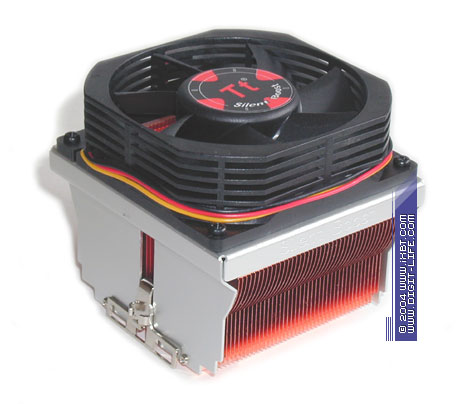
 The heatsink is based on the bonded fin technology and has worthy fin parameters (the fins are only 0.1 mm think, the total heat-transfer area makes 2200 cm2). In contrast to Volcano 11 whose fins were glued with thermal grease (which made a negative effect on the heatsink's thermal parameters), this cooler has its fins soldered to the base, with the contact thermal resistance being minimal. That is why it's hardly possible that such cooler will behave unexpectedly.  Thermaltake Volcano 11 and Silent Boost heatsinks Panaflo FBL08A12M fan from Matsushita Electric (actually Panasonic) has an aggressive configuration of the blades and the grid body. Such engineering solution allows for well balanced aerodynamic and acoustic characteristics: the optimized impeller generates a strong air blow and the pipe's net acts as a secondary inlet increasing the air flow even more and reducing structural vibrations typical of the solid fan design. The Hydro Wave bearing (an advanced version of the sliding bearing) reduces the mechanical noise coming from the fan.  Silent Boost demonstrates very good thermal efficiency and maintains noise at the acceptable ergonomic level. As a result, Silent Boost hits the top ten of the Efficiency/Noise rating and takes a high position in the summary table. Titan TTC-D9TB/CU35/R1 and TTC-CU9TB/SCNow we have two new-comers from Titan - TTC-D9TB/CU35/R1 and TTC-CU9TB/SC. TTC-D9TB/CU35/R1 is a mid-budget solution; it's based on the D5T series and extends the features of TTC-D5TB/G/CU35. The new cooler has a wider heatsink, 80x80x40 mm (80x60 mm base) with the improved finning (trapezoid fins, 0.8 mm thick base and 0.4 mm thick on top) and a copper disc 35 mm in diameter, a pretty fan, 80x80x35 mm, 2300 rpm, and a 6-point mount. 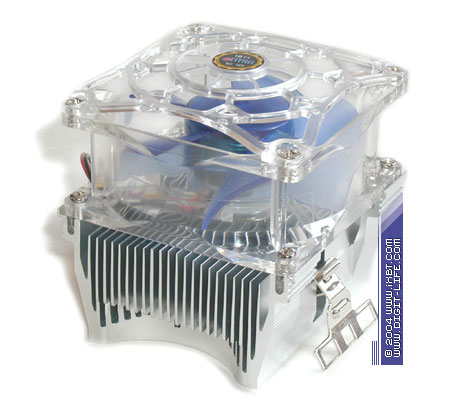 TTC-D9TB/CU35/R1 has two cutouts in the heatsink's base, but it's not clear why - such holes worsen the parameters and are designed definitely not for proper installation because the cooler does leave the required area around the socket. 
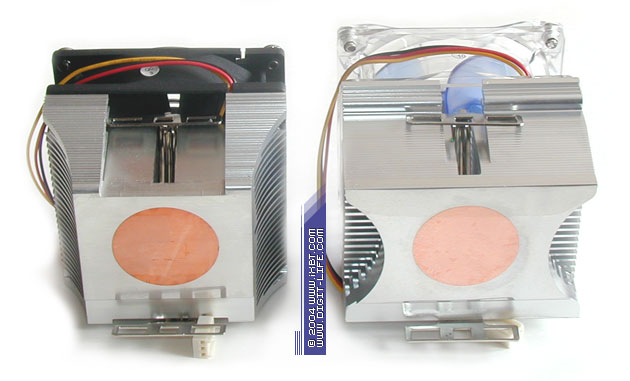 Although TTC-D9TB/CU35/R1 has a good combination of the parameters its performance doesn't look that good: the cooler yields to its predecessor TTC-D5TB/G/CU35/SC in the summary table. Another new solution is TTC-CU9TB/SC. At first glance, it looks very impressive - it's based on the copper heatsink, 82X63x37 mm (45x63 mm base) with the advanced finning (0.1 mm think, the heat-transfer area is 2000 cm2), is equipped with a high-speed fan, 70x70x25 mm, and a 6-point mount. 
 In addition, TTC-CU9TB/SC comes with a potentionmeter (identical to the one coming with TTC-D5TB/G/CU35/SC) which allows you to change the impeller speed from 2200 to 4200 rpm.  The guys at Titan didn't learn the lesson of Volcano 11 and made a similar solution - they glued the fins to the sink base with a thick layer of thermal grease, thus, tremendously increasing the full thermal resistance. TTC-CU9TB/SC follows Volcano 11: at the minimal speed of rotation the cooler shows the worst efficiency and at the maximum speed it falls behind even budget-level TTC-D5TB/G/CU35 and TTC-D9TB/CU35/R1. As a result, TTC-CU9TB/SC takes bottom positions in the ratings. Zalman CNPS7000A-AlCu and CNPS7000A-CuZalman CNPS7000A-AlCu and CNPS7000A-Cu have the design identical to their relatives - CNPS7000-AlCu and CNPS7000-Cu, except a slightly altered heatsink base (these two models were reviewed last time and showed excellent scores). Suffix A means that the coolers have an additional mount adapted for Socket A. 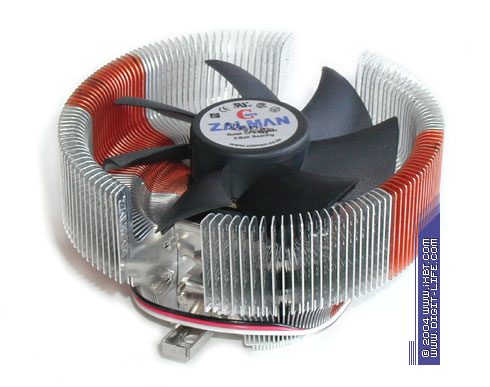 Zalman CNPS7000A-AlCu 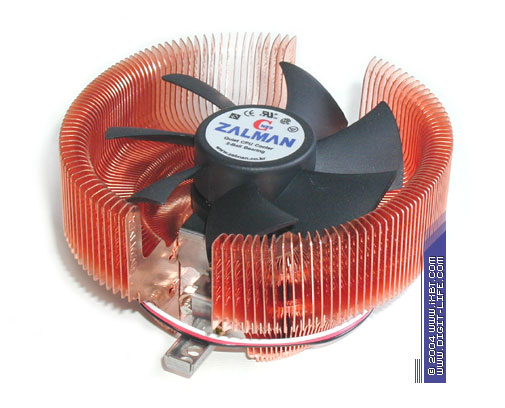 Zalman CNPS7000A-Cu The CNPS7000A duet demonstrates the same stunning combination of qualities. The all-copper CNPS7000A-Cu repeats the brilliant success of CNPS7000-Cu and becomes an absolute champion - it shows prime noise ergonomics outscoring all other contestants in the efficiency/noise tests. CNPS7000A-AlCu goes on a par with Cooler Master Aero 7+ and GlacialTech Igloo 2510 Pro in the thermal efficiency tests and boasts of its pleasant noise ergonomics. Meanwhile, not every user can benefit from the CNPS7000A coolers as they are compatible with quite a narrow range of mainboards. If you look at the list of mainboards you will see that more than a half of them are incompatible with CNPS7000A because they don't have needed holes around the socket, and some other boards can become compatible if you modify the cooler's clip. Besides, the heatsink of CNPS7000A is wider than needed (80 mm) - and this is one more factor that makes the list of compatible boards even narrower. Such cooler needs the socket be seated deeply in mainboard so that the sink doesn't fall over its edges. Otherwise, when installing the board you must provide an gap (at least 1.5 cm) between its top and the bottom of the PC case power supply unit as the latter might not let you install the cooler. Finally, you have to demount the mainboard with all its components installed, attach the brackets to the holes in the board, fix the clip in these brackets and install the mainboard back into the PC case. Isn't it much for one cooler?! The mounting system is the only weak point of CNPS7000A-AlCu and CNPS7000A-Cu coolers, but this disadvantage doesn't let them have the combination of qualities matching their perfect performance. Part 2. Test Results (temperature, thermal resistance, noise level)
Part 3. Ratings (technical-economical coolers map, performance and economical ratings)Appendix. Coolers
consumer qualities assessment (New Edition)
Vitaly Krinitsin (vit@ixbt.com)
Write a comment below. No registration needed!
|
Platform · Video · Multimedia · Mobile · Other || About us & Privacy policy · Twitter · Facebook Copyright © Byrds Research & Publishing, Ltd., 1997–2011. All rights reserved. |